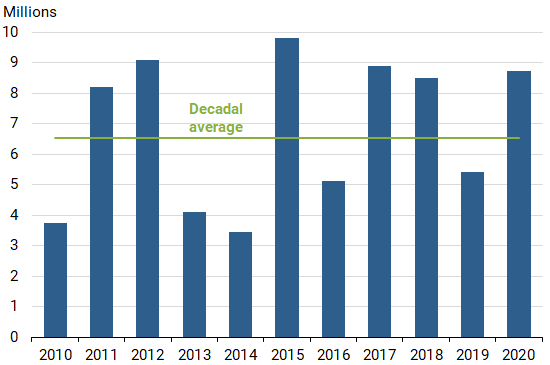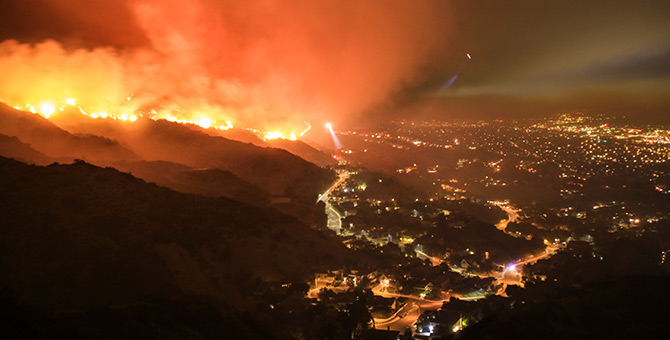The 2020 wildfire season has raged for months throughout the United States. A combination of persistent drought conditions, strong winds, heat waves, and lightning storms has resulted in one of the most widespread burn seasons in recent memory, especially in California and the western United States.
Though it is too early to tally the full extent of the damage, comparing some data with previous fire seasons can give us a hint.
Estimating fire damage for 2020
As of November 13, the National Interagency Fire Center (NIFC) recorded 49,815 wildfire incidents in 2020. These wildfires have burned over 8.7 million acres so far—and the NIFC expects the season to continue well into December in parts of California, Texas, and Oklahoma.
This partial accounting places the current fire season among the largest over the past decade. Figure 1 shows the number of acres burned by wildfires between January 1 and November 13 each year since 2010. The number of acres burned so far this year is approximately 2.2 million higher than the annual average over the 2010s. This also places the current fire season as the fourth largest since 1980 in terms of the geographical area burned.
Year-to-date acres burned in the United States

Looking at similar recent fire seasons can give us a ballpark estimate of the eventual value of damages. Figure 1 suggests that the 2020 wildfire season could be comparable to the 2017 and 2018 seasons, which were the most destructive in recent history. According to the Insurance Information Institute (I.I.I.), insured and uninsured losses totaled nearly $21 billion in 2017 and $24 billion in 2018, valued in 2019 dollars and adjusted for inflation. This is seven to eight times larger than losses in 2007 and 2008, two of the most damaging previous seasons on record in terms of annual losses.
How is the western United States faring this year?
Considering how each fire season differs from year to year and state to state, early estimates of damages for the 2020 season are highly uncertain.
As of mid-November, although the number and intensity of fires had diminished, twenty-five large fires were still active in California, Colorado, Montana, Oregon, Utah, Washington, and Wyoming. This collection of active individual and grouped fires had already consumed around 2 million acres, accounting for about a fourth of the acreage burned nationwide in 2020.
Conditions in some western states confirm that the current season is nearing—and may have already surpassed—recent records.
- In Oregon, where fires have destroyed towns and forced many thousands of residents to evacuate, more than a million acres had burned as of early November, according to the Northwest Interagency Coordination Center. That makes the current fire season the state’s second largest in over 20 years.
- In California, fires have raged from north to south, engulfing nearly 4.2 million acres thus far, including wine-producing areas and highly populated regions. That is more than twice as much area as the state’s 2018 fire season, which had been its most devastating in several decades, according to CalFire records.
- In Washington State, more acres have burned in 2020 than in each of the past 12 fire seasons according to the I.I.I.
Overall damage and cost estimates for the 2020 fire season remain uncertain. The estimates will depend on factors ranging from complex fire suppression programs to the value of buildings and infrastructure destroyed by the fires. While more burned acreage translates to higher costs of fighting the fires, it does not necessarily result in more damage to structures. In Oregon, the current fire season has destroyed thousands of homes—exponentially worse than the dozens of homes lost in other recent seasons. In California, over 10,000 structures have been damaged, similar to the 2017 fire season but less than half the number of damaged buildings in 2018.
Trends for a fiery future
Although the current season appears similar to 2017 and 2018, this comparison can only serve as an early hint of the eventual actual value of total damages. It will take several months for more formal estimates to be published.
While we wait for official data, however, there is no doubt surrounding the longer-term trend toward more severe wildfire seasons. This is especially true in states within the Federal Reserve’s 12th District. Data show that our economy is considerably more exposed to wildfire risk than other parts of the country. Not only are wildfires more prevalent, but also more people live, work, and contribute to their local economy in areas that are more prone to wildfires.
Moreover, climate change is expected to cause days to get hotter and swings between drought and wet years to become more dramatic in California and elsewhere. Under this trend, projections from a recent analysis suggest that the 12th District’s wildfire risk will intensify over the next two decades. Learn more about this risk in our recent Economic Letter: Rising Wildfire Risk for the 12th District Economy.
Luiz E. Oliveira is an associate economist in the Economic Research Department of the Federal Reserve Bank of San Francisco.
Image credit: Oliver Knight via iStock.
The views expressed here do not necessarily reflect the views of the management of the Federal Reserve Bank of San Francisco or of the Board of Governors of the Federal Reserve System.
